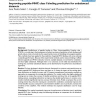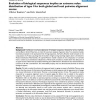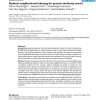BMCBI
2008
13 years 11 months ago
2008
Background: Establishment of peptide binding to Major Histocompatibility Complex class I (MHCI) is a crucial step in the development of subunit vaccines and prediction of such bin...
BMCBI
2008
13 years 11 months ago
2008
Background: We have developed a new computational algorithm, Shape-IT, to infer haplotypes under the genetic model of coalescence with recombination developed by Stephens et al in...
BMCBI
2008
13 years 11 months ago
2008
Background: Confidence in pairwise alignments of biological sequences, obtained by various methods such as Blast or Smith-Waterman, is critical for automatic analyses of genomic d...
BMCBI
2008
13 years 11 months ago
2008
Background: Multifactor Dimensionality Reduction (MDR) has been introduced previously as a non-parametric statistical method for detecting gene-gene interactions. MDR performs a d...
BMCBI
2008
13 years 11 months ago
2008
Background: Gene Ontology (GO) annotation, which describes the function of genes and gene products across species, has recently been used to predict protein subcellular and subnuc...
BMCBI
2008
13 years 11 months ago
2008
Background: Microarray analysis allows the simultaneous measurement of thousands to millions of genes or sequences across tens to thousands of different samples. The analysis of t...
BMCBI
2008
13 years 11 months ago
2008
Background: Similarity inference, one of the main bioinformatics tasks, has to face an exponential growth of the biological data. A classical approach used to cope with this data ...
BMCBI
2008
13 years 11 months ago
2008
BMCBI
2008
13 years 11 months ago
2008
Background: Spatially mapped large scale gene expression databases enable quantitative comparison of data measurements across genes, anatomy, and phenotype. In most ongoing effort...
BMCBI
2008
13 years 11 months ago
2008
Background: Detecting conserved noncoding sequences (CNSs) across species highlights the functional elements. Alignment procedures combined with computational prediction of transc...





